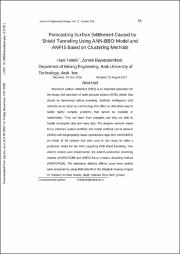| dc.contributor.author | Fattahi, Hadi | en_US |
| dc.contributor.author | Bayatzadehfard, Zohreh | en_US |
| dc.date.accessioned | 1399-08-23T06:10:01Z | fa_IR |
| dc.date.accessioned | 2020-11-13T06:10:02Z | |
| dc.date.available | 1399-08-23T06:10:01Z | fa_IR |
| dc.date.available | 2020-11-13T06:10:02Z | |
| dc.date.issued | 2019-05-01 | en_US |
| dc.date.issued | 1398-02-11 | fa_IR |
| dc.identifier.citation | (1398). نشریه زمین شناسی مهندسی, 12(5), 55-84. doi: 10.18869/acadpub.jeg.12.5.55 | fa_IR |
| dc.identifier.issn | 2228-6837 | |
| dc.identifier.issn | 7386-8222 | |
| dc.identifier.uri | https://dx.doi.org/10.18869/acadpub.jeg.12.5.55 | |
| dc.identifier.uri | http://jeg.khu.ac.ir/article-1-2583-en.html | |
| dc.identifier.uri | https://iranjournals.nlai.ir/handle/123456789/580772 | |
| dc.description.abstract | Maximum surface settlement (MSS) is an important parameter for the design and operation of earth pressure balance (EPB) shields that should determine before operate tunneling. Artificial intelligence (AI) methods are accepted as a technology that offers an alternative way to tackle highly complex problems that can’t be modeled in mathematics. They can learn from examples and they are able to handle incomplete data and noisy. The adaptive network–based fuzzy inference system (ANFIS) and hybrid artificial neural network (ANN) with biogeography-based optimization algorithm (ANN-BBO) are kinds of AI systems that were used in this study to build a prediction model for the MSS caused by EPB shield tunneling. Two ANFIS models were implemented, ANFIS-subtractive clustering method (ANFIS-SCM) and ANFIS-fuzzy c–means clustering method (ANFIS-FCM). The estimation abilities offered using three models were presented by using field data of achieved from Bangkok Subway Project in Thailand. In these models, depth, distance from shaft, ground water level from tunnel invert, average face pressure, average penetrate rate, pitching angle, tail void grouting pressure and percent tail void grout filling were utilized as the input parameters, while the MSS was the output parameter. To compare the performance of models for MSS prediction, the coefficient of correlation (R2) and mean square error (MSE) of the models were calculated, indicating the good performance of the ANFIS-SCM model. | en_US |
| dc.format.extent | 1390 | |
| dc.format.mimetype | application/pdf | |
| dc.language | English | |
| dc.language.iso | en_US | |
| dc.publisher | دانشگاه خوارزمی | fa_IR |
| dc.relation.ispartof | نشریه زمین شناسی مهندسی | fa_IR |
| dc.relation.ispartof | Journal of Engineering Geology | en_US |
| dc.relation.isversionof | https://dx.doi.org/10.18869/acadpub.jeg.12.5.55 | |
| dc.subject | Maximum surface settlement | en_US |
| dc.subject | EPB shield | en_US |
| dc.subject | Shield tunneling | en_US |
| dc.subject | Adaptive network–based fuzzy inference system | en_US |
| dc.subject | Artificial neural network | en_US |
| dc.subject | Biogeography-based optimization algorithm. | en_US |
| dc.subject | Geotecnic | en_US |
| dc.title | Forecasting Surface Settlement Caused by Shield Tunneling Using ANN-BBO Model and ANFIS Based on Clustering Methods | en_US |
| dc.type | Text | en_US |
| dc.type | Original Manuscript | en_US |
| dc.contributor.department | Department of Mining Engineering, Arak University of Technology, Arak, Iran | en_US |
| dc.contributor.department | Department of Mining Engineering, Arak University of Technology, Arak, Iran | en_US |
| dc.citation.volume | 12 | |
| dc.citation.issue | 5 | |
| dc.citation.spage | 55 | |
| dc.citation.epage | 84 | |





